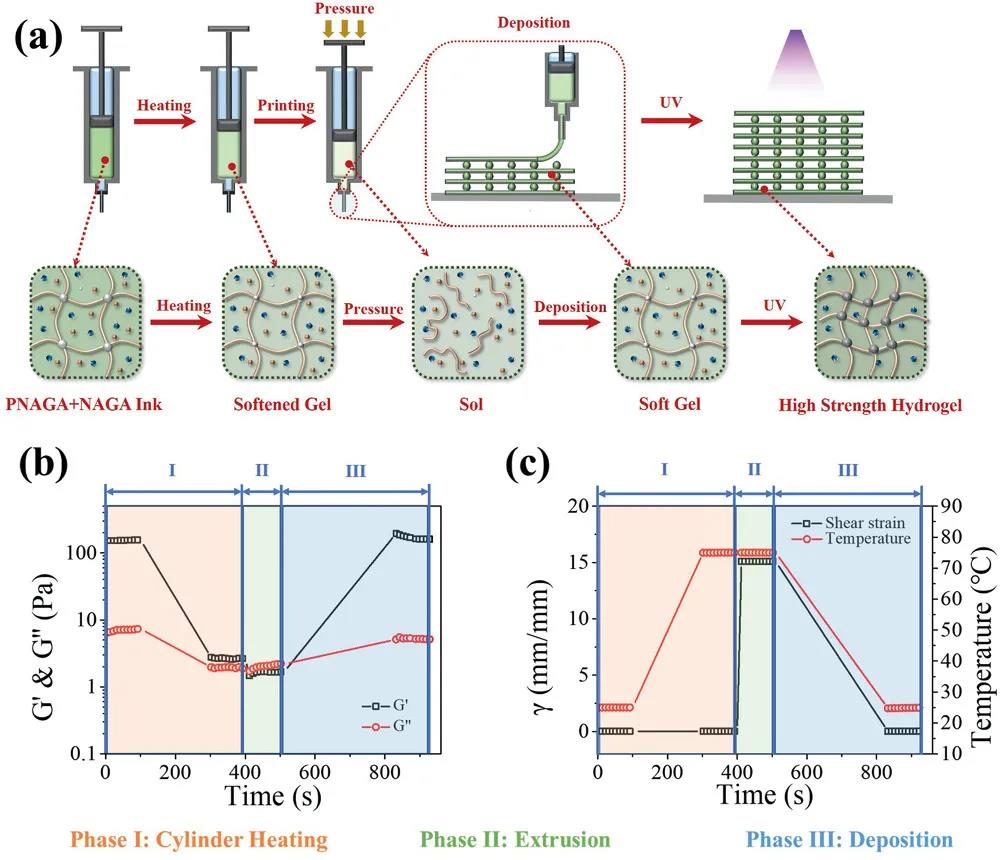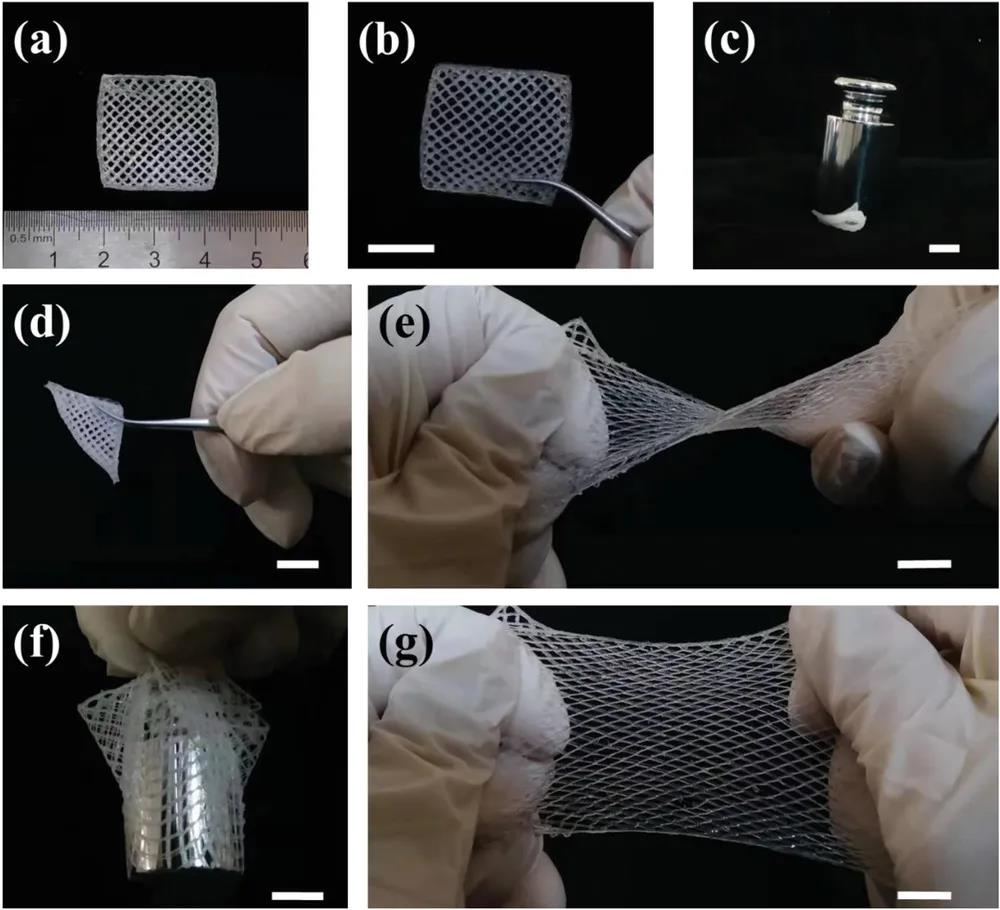
hotline:
17715390137
Tel/Wechat:
18101240246 (Technology)
0512-68565571
Email:mxenes@163.com (Sales Engineer)bkxc.bonnie@gmail.com
Scan the code to follow or search the official account on WeChat:
2D Materials Fronrier After paying attention,
click on the lower right corner to contact us,
Enter enterprise WeChat.
Professional Services Online

Meniscus injuries can cause impaired knee function, significant pain and even disability. Although the current meniscus resection strategy can partially relieve pain, there is still a risk of articular cartilage degeneration and even osteoarthritis. There is an urgent need to design and construct meniscus substitutes that have similar geometric shapes as natural meniscus, high mechanical properties, and swelling stability under physiological conditions. Recently, the booming 3D printing technology provides new possibilities for personalized therapy. However, due to the lack of inherent swelling resistance, most high-strength hydrogel printing systems cannot maintain their original mechanical properties and pre-designed in an aqueous environment. Size, which seriously hinders their application in physiological environments. As far as the meniscus is concerned, there are few studies devoted to the manufacture of high-strength and anti-swelling stable hydrogels to evaluate their application as meniscus replacements in the body.
Recently, the team of Professor Wenguang Liu of Tianjin University used supramolecular poly(N acryloyl glycinamide) (PNAGA) hydrogel to propose a self-thickening and self-reinforcing strategy, which is to load the concentrated NAGA monomer into a thermoreversible In the low-strength PNAGA hydrogel, the hydrogen bond can be directly 3D printed to enhance the hydrogel. After 3D printing the self-thickening high-strength PNAGA hydrogel, it was implanted into the rabbits knee as a substitute, showing the ability to effectively alleviate the cartilage surface wear. The self-thickening strategy is suitable for direct printing of various polymer hydrogel-based tissue engineering scaffolds without sacrificing mechanical strength, thereby avoiding the problem of printing high-strength hydrogels and expanding its application range. Related work was published on Advanced Functional Materials with the title "A Self-Thickening and Self-Strengthening Strategy for 3D Printing High-Strength and Antiswelling Supramolecular Polymer Hydrogels as Meniscus Substitutes".

【Self-thickening and self-enhancement strategy design】
The core idea of self-thickening and self-reinforcement strategy is to prepare low-concentration low-strength thermoreversible PNAGA hydrogel, and then load concentrated NAGA monomer into it to form ink. Low-strength PNAGA hydrogel can thicken concentrated NAGA It is a single body and is printed by thermally assisted 3D printing technology. After printing, the encapsulated concentrated NAGA is further polymerized, which offsets the low strength of the pre-added PNAGA thickener.

Schematic diagram of self-thickening and self-reinforcing strategies for 3D printing of high-strength and anti-swelling PNAGA supramolecular polymer hydrogels
[Preparation and characterization of PNAGA + NAGA ink]
Heat the PNAGA soft hydrogel (3, 3.5 and 4 wt%) to the sol state, and then dissolve a certain amount of NAGA monomer (15, 20, 25 and 30 wt%) and photoinitiator (IRGACURE 1173) to obtain a uniform PNAGA + NAGA mixture. After cooling to room temperature, the PNAGA + NAGA mixture can form a thermoreversible soft gel. Rheological tests showed that the load of more monomers resulted in a lower transition temperature, and as the NAGA concentration further increased, the transition temperature decreased more. The ink has shear thinning behavior and heat-sensitive recovery behavior. PNAGA+NAGA ink is very beneficial for extrusion-based 3D printing and can maintain the excellent printing accuracy of the extruded hydrogel line.

Rheological test of PNAGA+NAGA ink with different proportions
【Preparation and Characterization of PNAGA-X-Y Hydrogel】
In order to make these PNAGA+NAGA inks into high-strength hydrogels, the encapsulated NAGA monomers must be polymerized by the preloaded photoinitiator. The hydrogels obtained at this time are called PNAGA-XY hydrogels (X represents NAGA concentration of PNAGA soft hydrogel, Y represents the concentration of NAGA monomer loaded afterwards). The PNAGA-X-Y hydrogel prepared by this two-step method has good swelling resistance, which is beneficial to maintaining the structural stability and mechanical properties of the printed structure. It also exhibits concentration-dependent mechanical properties. The polymerization of the added monomer does not affect the mechanical and swelling behavior. This will allow 3D printing of supramolecular PNAGA hydrogels with mechanical strength and resistance to swelling

Mechanical properties of PNAGA hydrogel
【3D printing self-thickening ink】
Considering that the viscosity of PNAGA + NAGA ink in the sol state is too low to be extruded into continuous filaments, before printing, the PNAGA + NAGA hydrogel was pretreated by heating, but the temperature was controlled to be specific The gel-sol transition temperature is 10°C lower. At this temperature, the PNAGA + NAGA ink still maintains a gel state, and the hydrogen bond cross-linking is only partially broken before extrusion. This prevents ink from leaking from the nozzle and ensures that a continuous line is extruded with high fidelity. When air pressure is applied to the ink, a gel-sol transition occurs. This shear thinning function allows the ink to easily pass through the nozzle, thereby maintaining the smooth surface of the extrusion line. After the ink is ejected from the nozzle due to the elimination of heating and shear stress, the reformed hydrogel is deposited on the platform. On this platform, the filaments can well support the entire structure of the printing structure, and on it The fidelity is higher. After depositing the hydrogel filaments on the platform, UV was applied to initiate the free radical polymerization of the loaded concentrated NAGA monomer. Finally, a 3D printed PNAGA hydrogel structure with excellent mechanical strength and swelling stability can be obtained.

PNAGA + NAGA ink printing process and corresponding structural changes
The researchers printed a series of PNAGA-hydrogel-based architectures through melt-extrusion 3D printing technology. Print a flexible rectangular grid (length: 20 mm; width: 20 mm; thickness: 2 mm), and a rectangular grid structure with different layer numbers (length: 20 mm; width: 20 mm; layer height: 0.5) mm; nozzle inner diameter: 0.51 mm) and a larger area (length: 70 mm; width: 70 mm; thickness: 0.6 mm) hydrogel printing net. The results prove that PNAGA hydrogels can be printed through a self-thickening and self-reinforcement mechanism without sacrificing its bulk strength, which provides the powerful mechanical properties of the printed PNAGA hydrogel structure.

Macroscopic observation of the 3D printed PNAGA-4%-30% hydrogel structure
In order to confirm the universality of the self-thickening strategy, several polymers with different side groups (for example, neutral, anionic and zwitterionic) were selected (for example, polyacrylamide (PAAm), poly(carboxybetaine acrylamide)) (PCBAA) ), polyacrylic acid (PAAc) and poly(2-acrylamide-2-methylpropyl sulfonic acid) (PAMPS) compounds to prepare inks. Compared with the monomer solution, the viscosity of the corresponding polymer + monomer mixture And shear-thinning behavior is significantly higher. This self-thickening strategy can be extended to print a variety of polymers without adding external thickeners. Of course, due to the lack of strong hydrogen bond interactions, these hydrogel structures are Mechanically much weaker than the printed PNAGA hydrogel.

Various systems of monomer solution, polymer solution and polymer + monomer ink viscosity and 3D printing
[In vivo implantation of meniscus stent]
The researchers printed a meniscus stent based on PNAGA hydrogel, which was implanted in the rabbits knee joint and the meniscus was completely removed from the hind legs. Four weeks after the operation, observations of the gait of the rabbit revealed that due to the lack of meniscus protection, the positive group (with the meniscus removed) could not walk or jump forward normally. In contrast, the rabbits implanted with the PNAGA meniscus replacement (experimental group) behaved normally. Compared with the meniscus resection group, less abrasion was observed in the experimental group, which indicates that the implantation of the 3D printed PNAGA hydrogel stent can protect cartilage lesions well.

3D printed PNAGA hydrogel-based stent and its application as a meniscus replacement in the body
Summary: Researchers have proposed a self-thickening and self-reinforcing strategy to directly print high-strength hydrogels that have the ability to maintain strong mechanical properties. First, an injectable flexible supramolecular polymer hydrogel is prepared, then it is loaded with concentrated monomers and initiators to form a self-thickening ink, and then it is printed directly into the self-supporting hydrogel structure. The polymerization of the back-loaded monomer compensates for the self-reinforcing effect of the polymerized monomer, resulting in firm hydrogel printing. Supramolecular PNAGA hydrogels can be printed on high-strength and anti-swelling structures, which are created by the reconstruction of strong hydrogen bonds between bisamides. This strategy is suitable for direct printing of a variety of polymer hydrogels without the need for additional thickeners. In view of the high strength and anti-swelling ability in the water environment, the self-thickening high-strength PNAGA hydrogel is printed to replace the function of the rabbits meniscus. In vivo results show that the printed PNAGA hydrogel meniscus replacement can effectively alleviate the cartilage surface wear. This self-thickening and self-reinforcing strategy can be extended to a wide range of customized high-strength hydrogel scaffolds for personalized treatment of degenerative weight-bearing soft tissues.

| Reminder: Beijing Beike New Material Technology Co., Ltd. supplies products only for scientific research, not for humans |
| All rights reserved © 2019 beijing beike new material Technology Co., Ltd 京ICP备16054715-2号 |